Dog-friendly backyard ideas – 10 ways to create a stylish and safe space for you and your pet
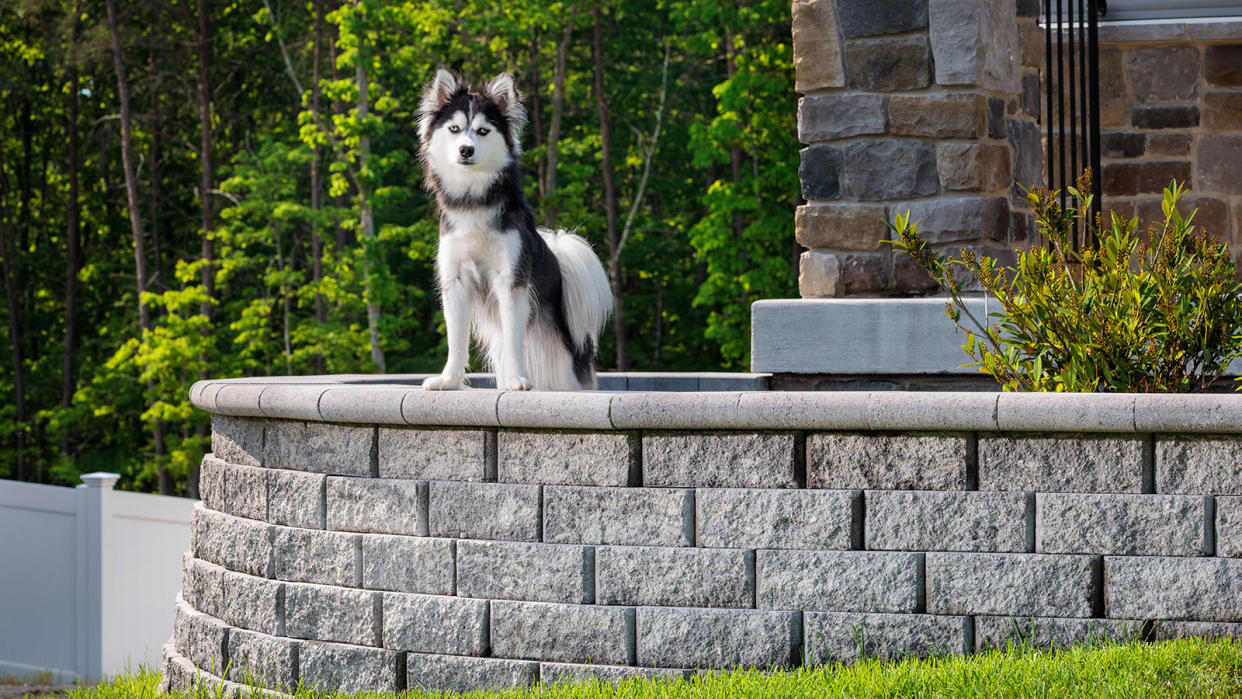
Are you a proud pet parent? If so, creating a dog-friendly backyard is all important for both you and your pooch.
We all long for a beautiful yard to gaze upon from the house and a leafy space we can unwind in with family and friends, but if you also have the needs of a canine member to accommodate achieving this can seem thwarted with problems and unattractive compromises.
Working out how to subtly divide off doggy digging areas to knowing which plants are safe and potentially harmful to dogs, are all commonly faced problems. Other headaches when choosing pet-friendly backyard ideas include finding ground cover and paving options that are dig-proof, easy to clean as well as affordable and attractive, along with whether to opt for a real or artificial lawn. Sound familiar? Well, we’ve spoken to our panel of trusted garden design and pet care experts, to get their advice.
10 ways to create a dog-friendly backyard
Whether you're tired of trying to keep your dog off your flower beds, or simply want to give your pet a more engaging outdoor space, there are plenty of ways to make your backyard more dog-friendly so they can happily (and safely) spend time playing outdoors.
1. Get the hard landscaping right
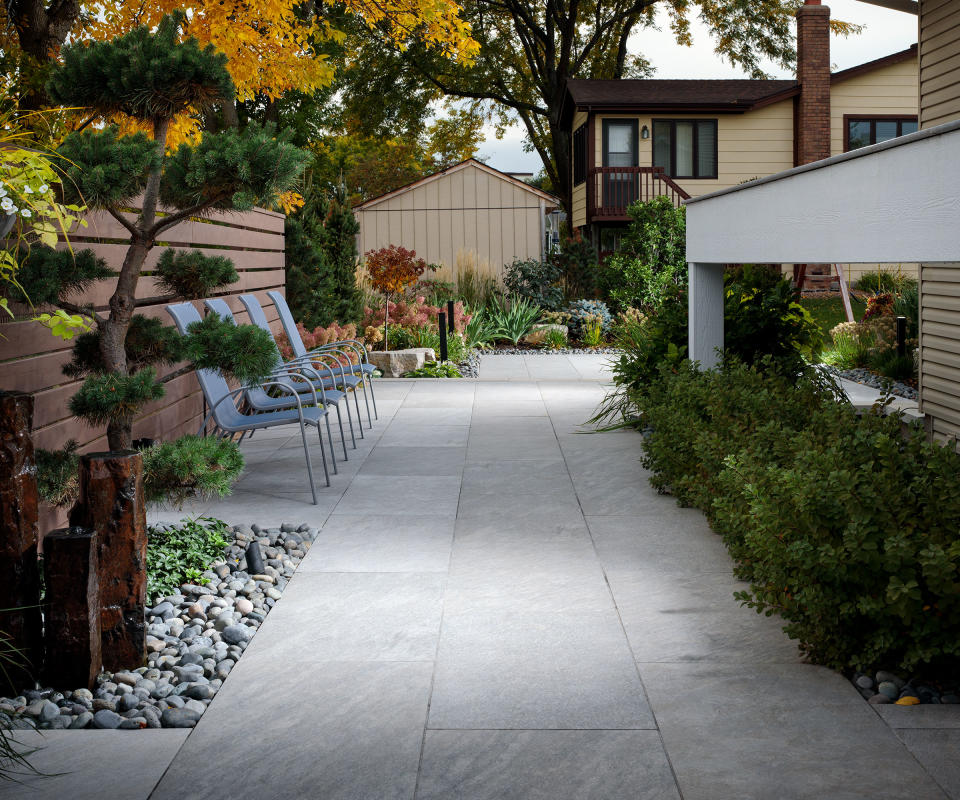
Striking balance between providing an attractive, pet-stimulating space that is also quick and easy to maintain can at first seem impossible but there are a few simple tips to try.
‘Grass-free lawns are becoming a popular alternative, especially in areas with less rainfall, with homeowners opting for hardscapes to reduce maintenance and water usage,’ says Joe Raboine, Vice President of Design at Belgard. 'If you choose to hardscape areas of the yard, be sure to select concrete or porcelain pavers, as they provide the most durability.’
Besides choosing these exceptionally hardwearing and virtually nonporous surfaces for your backyard landscaping, there are other precautions you can take to help cut down on maintenance and to reduce the risk of any staining occurring.
‘Sealing your pavers is also key to keeping them looking and performing their best,' explains Joe. 'Apply sealant once your installation is complete to start with a base of protection. It is recommended to reapply a sealant once every three to five years – after a thorough cleaning of the area – to ensure pavers maintain their color and freshness.’ Sealing joints and any grout lines is another worthwhile trick to keep your paved backyard looking its best.
‘Just like you would clean up after your dog on a walk, make sure to clean up your hardscapes,' adds Joe. 'Large-format pavers are an ideal option, minimizing the need to clear between tricky joints.’
2. Avoid plants that could be toxic to dogs
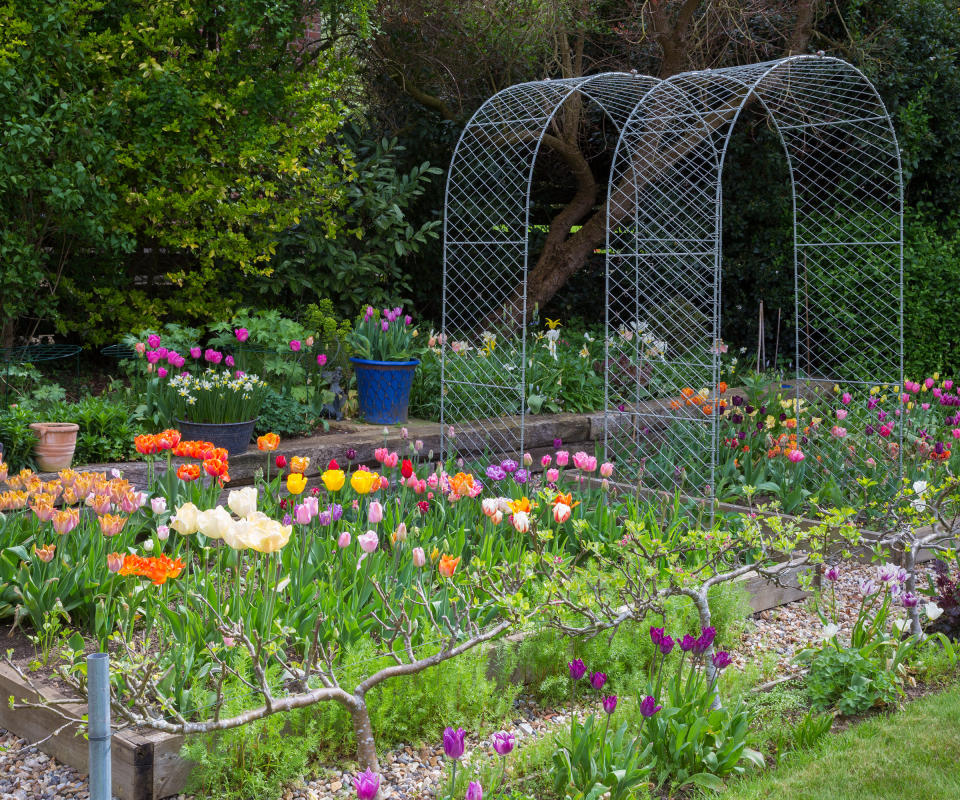
To truly relax and enjoy your outdoor space you need to be confident that it is safe and secure for your pooch, so you don’t have to monitor their every step outside. One aspect of their yards that homeowners often overlook is planting. Prickly beauties such as thistles, berberis, cotoneaster and ground cover roses are best avoided near paths or your pets favorite play place, but there are other less obvious issues to consider too.
Nicolas Wayne, founder of Nicolaslawn.com explains: ‘Some plants are poisonous to dogs, so it's essential to select pet-friendly plants carefully. Some commonly cited plants that can be toxic to dogs include azaleas and rhododendrons, tulips and hyacinths, lilies (including Easter, Tiger, and Asiatic lilies), foxgloves and oleander.’
Leading experts at Pet Poison Helpline say that ‘severe poisoning from hyacinth or tulip poisoning is often seen when dogs dig up freshly planted bulbs or have access to a large bag of them.’ Symptoms can range from drooling, vomiting to difficulty breathing, so if you have a particularly inquisitive pet, it is best to avoid having these plants in your flower beds.
3. Choose dog-friendly plant varieties instead
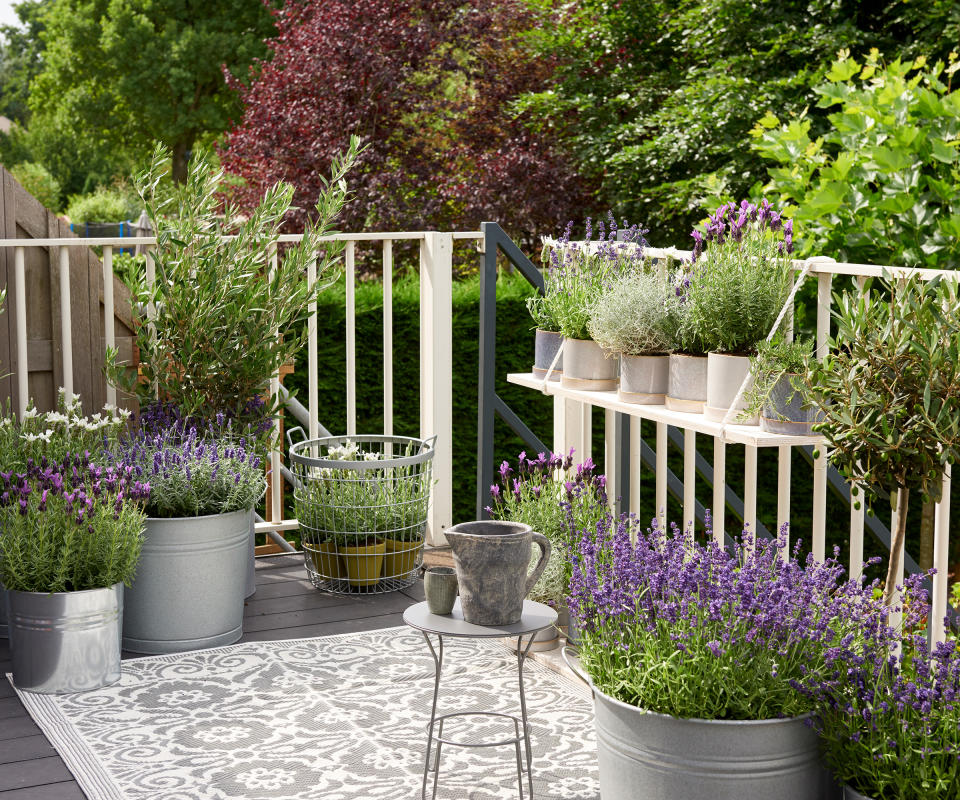
Of, course there are plenty of gorgeous, dog-friendly plants to choose for your backyard that pose no threat if brushed or eaten out of curiosity. Cheery sunflowers along with bright and breezy petunias, snapdragons, marigolds and zinnias are all brilliant long-lasting choices for filling your container garden, brightening borders and for planting in hanging baskets.
For the back of borders and dividing of boundaries and different sections of a yard, look for robust shrubs such as viburnum, camellia, bottle brush with its showy blooms and evergreen foliage, elegant magnolia and forsythia.
Besides many attractive pet-safe plants, some are even beneficial to your pooch. Rosemary, catnip, wormwood and many other fragrant, culinary herbs can deter fleas and help keep ticks and mosquitoes at bay. While lavender and German chamomile can help calm boisterous behaviour.
For complete peace of mind before planting anything in your yard, the American Society for the Prevention of Cruelty to Animals (ASPCA) has a comprehensive list of both toxic and non-toxic plants.
4. Consider an artificial lawn
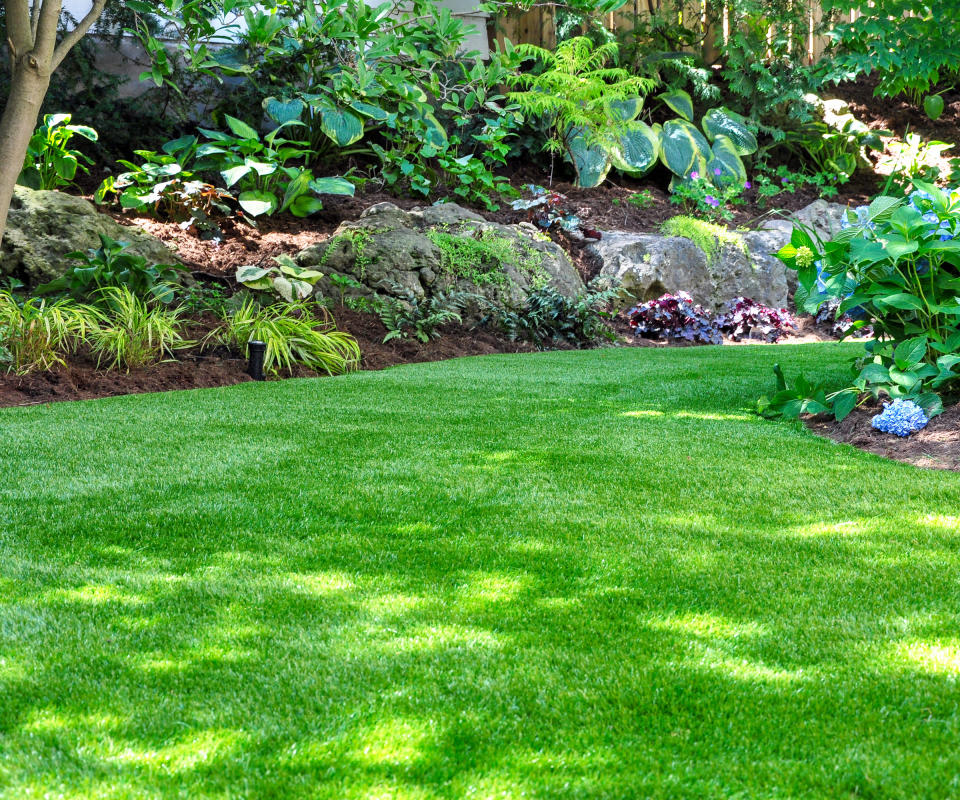
This is definitely a hotly debated subject, on which dog owners and garden professionals are divided. ‘As anyone with dogs is liable to know, dogs aren’t typically compatible with a lush lawn and perfect landscaping,’ says Ryan Farley, CEO of LawnStarter.com. ‘For a truly dog-friendly backyard, I might recommend dedicating most of the space to mulch or synthetic turf options that won’t get torn up or discolored by canine outdoor activities and play.’
There are many artificial lawn products that are specifically dog friendly. Often with an especially free draining backing that also has anti-bacterial qualities – helping to reduce smells and the dangerous build-up of mold and mildew, they are also manufactured to withstand repeated wear and tear. Easy to hose and brush down as needed, they can seem the ideal answer but there are a few potential downsides.
‘Artificial turf looks great and will stand up to wear and tear from paws. However, in the summertime, it heats up like the surface of the sun. It's been known to melt athletic cleats on hot days in the South,’ explains Eric DeBoer, agronomist for Simple Lawn Solutions. ‘If you want your pup to be able to enjoy your backyard during the summer months, the temperature of the surface could hinder their enjoyment.’
‘Your dog will also have less enjoyment trying to sniff, dig, and discover things in a plastic mat vs real soil and grass, Eric also points out. 'Overall, nothing will replicate the feel of walking through a natural grass lawn.’
5. Choose a pooch-tolerant grass variety

If you don't like the idea of a no-grass backyard or want to avoid artificial turf, then it's worth considering the type of grass you should grow. In terms of being peed on regularly or coping with the general wear and tear four paws can cause, some grasses can cope much better than others. The type of grass you grow will, firstly, depend on your local climate.
In southern regions warm-season grasses are a must. ‘Pound-for-pound Bermuda grass (Cynodon dactylon) or a hybrid Bermuda grass (Cynodon dactylon X C. transvaalensis) is going to be the best choice for homeowners with dogs,’ explains Eric DeBoer. ‘First, it has been shown, along with Zoysia grass (Zoysia spp.), to be most tolerant of urine. Second, it's just hard to kill and stands up to traffic really well. Third, it is a fast-growing grass seed under the correct circumstances, which can help it bounce back from any injury it incurs from traffic and urine. Zoysia will tolerate the urine but is a slow grower, so it will take a while to fill back in if any traffic or urine damage does occur.’ Pennington Bermuda grass seed from Walmart would be a suitable option to try.
In the US mid zone and northern states, cool season grasses that lie dormant between fall and early spring are the better option for lawns. There are a few varieties of grass seed and sod to choose from, but some are more dog-tolerant than others.
‘Cool-season grass owners will do best with tall fescue (Schedonorus arundinaceus) for dog urine damage,’ continues Eric. ‘For traffic, tall fescue is deeply rooted and will hold up well, but once it reaches the breaking point, getting it to recover and fill back in will feel impossible. Tall fescue is a bunch-type to weakly rhizomatous grass, so it doesn't fill in bare spots well, at all. Kentucky bluegrass (Poa pratensis) is bad for urine damage, but for traffic and recovery, you can't beat it for a cool-season lawn.
There are lots of tall fescue grass seed options available online, including this Scotts TurfBuilder tall fescue mix from Walmart.
'People in more northern climates looking to switch to a Bermuda grass for better dog-tolerance compared to cool-season turf, would do well by looking into improved cultivars of hybrid Bermuda grass like Tahoma 31, Latitude 36, Northbridge, and Iron Cutter,' adds Eric.
6. Make space for a pet-safe water feature
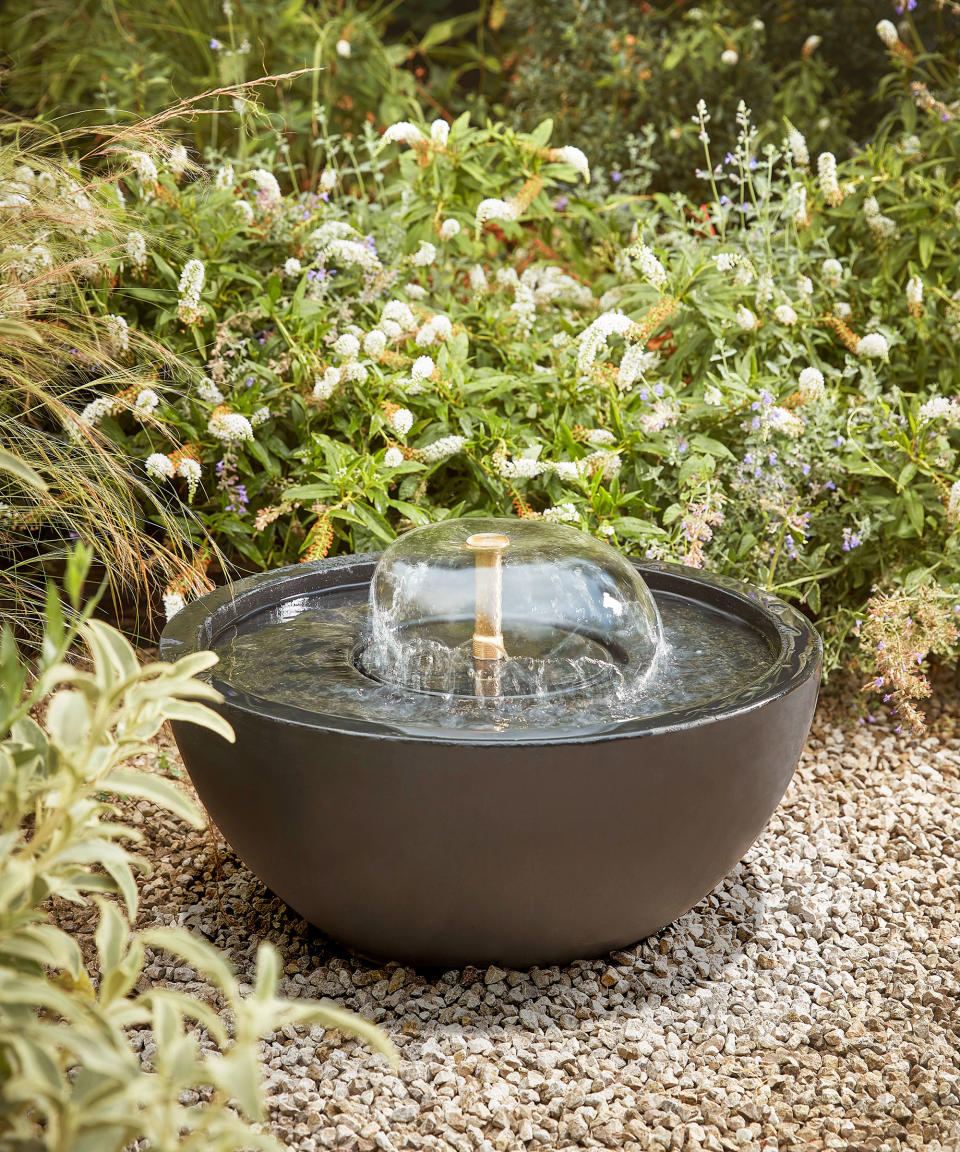
Shallow water feature ideas are the safest option for any dog-friendly yard, but some types are safer than others. ‘Avoid having any standing water in your backyard as it can be incredibly dangerous,’ advises Jeremy Yamaguchi, CEO of Lawn Love. ‘Standing water is the preferred egg-laying choice for mosquitoes. If your pet drinks from it, they're at risk of contracting diseases. Even if they don't, mosquitoes carry so many diseases including, most notably, Lyme disease.’
A ready supply of fresh or running water is both a safer and more entertaining option. For a small design, the XBrand round sphere water fountain from Walmart is similar to the design pictured.
For bigger backyards, there are also many play features that can be installed, ideal for keeping your pets (and friends) amused and refreshed in the hottest of weathers.
John Foraker, owner of My Splash Pad explains the types of things you can install in a residential backyard for your dog. ‘There are so many fun, entertaining features to choose from. These include things like a dog bowl play feature where water bubbles up from the bottom of the bowl and spill over the sides, a dog jump hoop with water jets, and dog wading pool with recirculating pump.’
7. Provide a shady spot for dogs to relax outdoors
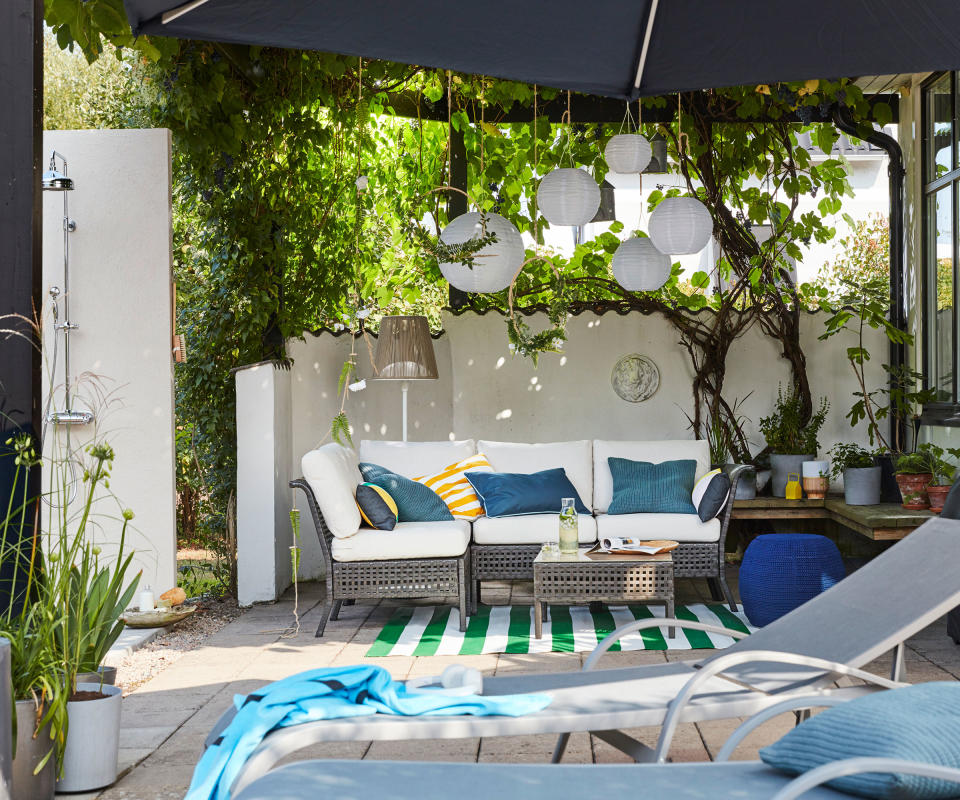
Overheating can be a serious issue for our furry friends, so providing some garden shade so they can escape the sun is essential. There are plenty of stylish shady solutions for every size plot, budget or design aesthetic. Simple garden parasols, sail shades and retractable awnings are perfect for patio covers or balcony shades, while more long-term solutions such as a gazebo, vine-clad pergola or even a summerhouse can provide reliable year-round respite.
Another long-term solution is to consider planting one or more trees as a way of creating a shady spot for your pet.
Choosing which trees to grow in your backyard depends on your local climate, the soil and growing conditions as well as the size of your plot. If you have plenty of space, oak trees, weeping willows, Sugar Maple, Gumbo Limbo and the Eastern Redbud are all brilliant options. While some are considered to be faster-growing trees than others, they all produce broad, leafy canopies that are perfect for lazing under.
For small backyards, there are plenty of shade-giving trees and shrubs that will thrive in containers. Provided the planters are large enough, with ample drainage and nutritious soil, you can enjoy some leafy shade up close to the house without any worry about wandering roots. Suitable trees for small backyards include Star magnolia, Japanese maples, olive trees and the majestic banana tree.
8. Protect your vegetable patch from curious dogs
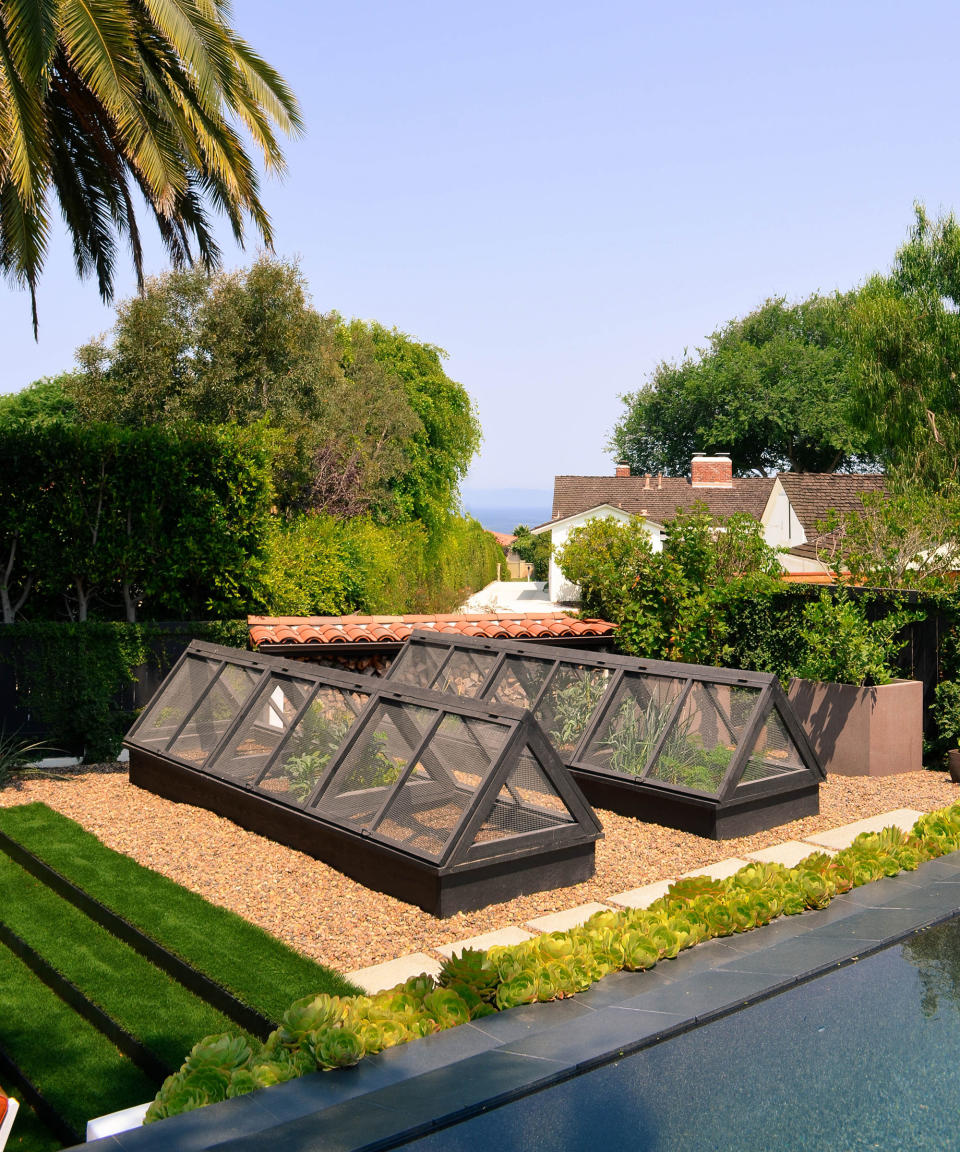
Whether you're planning to start a vegetable garden or already have one in your yard, you'll need to work out how to keep your curious canine from exploring every inch of your veg patch.
Dogs have an acute sense of smell, which can lead them right to your prize crops. Not only can this spell disappointment to you, but it can also prove dangerous for their health.
‘I like to enclose any backyard vegetable gardens to protect both the plants and the dogs,' says Megan Dufresne, principal designer at MC Design. 'This helps to avoid digging in the vegetable bed or accidentally eating something they shouldn't.’
There are endless ways to protect your homegrown fruit and vegetables. A series of smart triangular cold frames are ideal if you don’t wish to zone off your vegetable garden, while glass bell jars, wirework cloches and Victorian-style lanterns are good for covering vulnerable prize crops.
If your grow zone covers a larger area of your plot, then partitioning it off with robust dog-proof fencing or dense hedging plants (or both) is a practical and attractive option.
9. Utilize underused areas for play
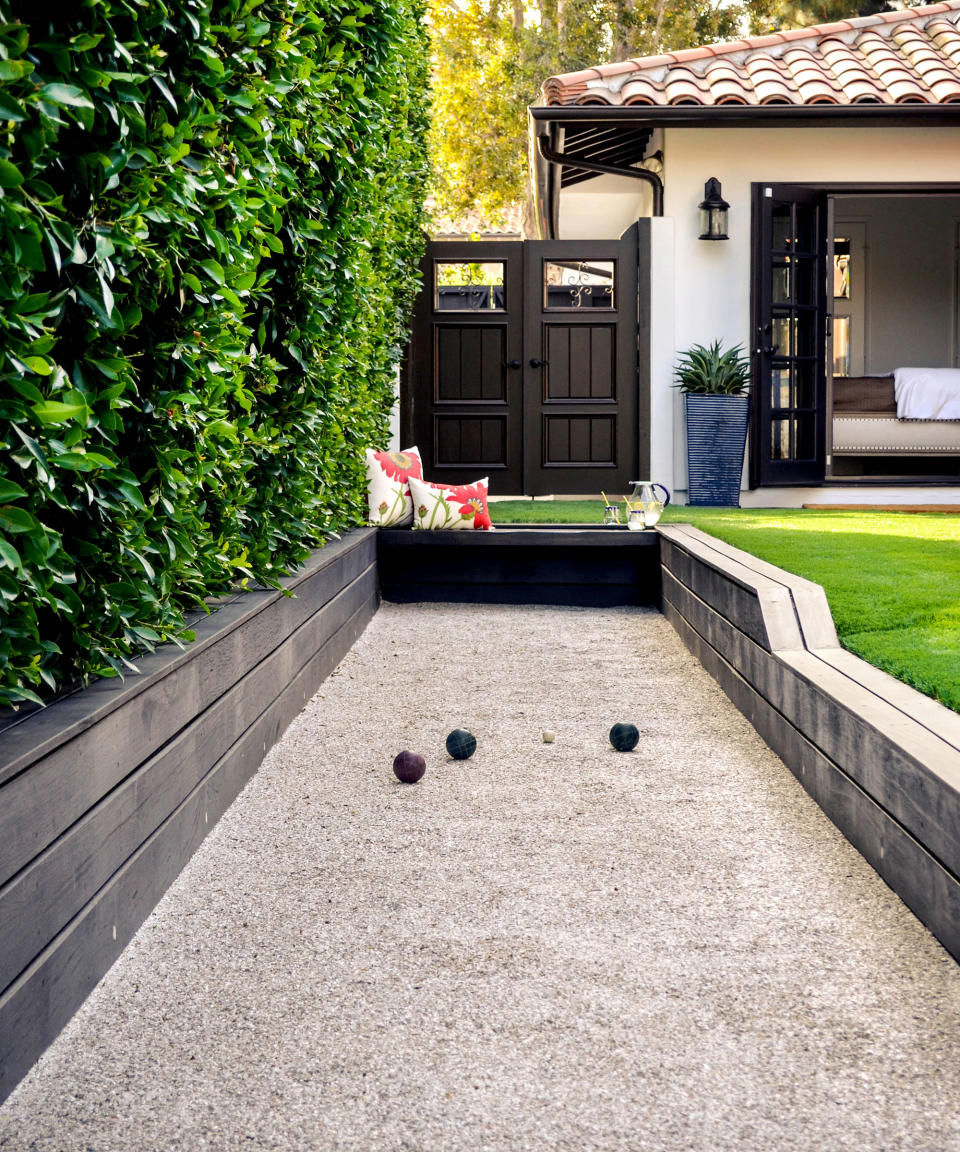
Don’t feel you have to let your pet take over your whole backyard, as dedicating a specific area for them can prove just as rewarding for them and give you peace of mind as well.
‘When designing a dog-friendly backyard I like to make sure I am efficient with my usage of space and take into consideration pet safety,’ says Megan Dufresne. ‘I like to activate often underused spaces like side yards or courtyards to create dog runs or play areas that can be gated off as needed.’
Angela Laws, community manager at Trusted Housesitters agrees: 'First, it is important to create a secure space: a secure fence is essential to keep your dog from escaping and ensure their safety. The fence should be tall enough, strong and have no gaps wide enough for your dog to get through. You should also remove any hazardous materials or objects from the play area, and make sure the area is free of any sharp edges or loose parts that could cause injury.’
10. Install dog-friendly boundaries
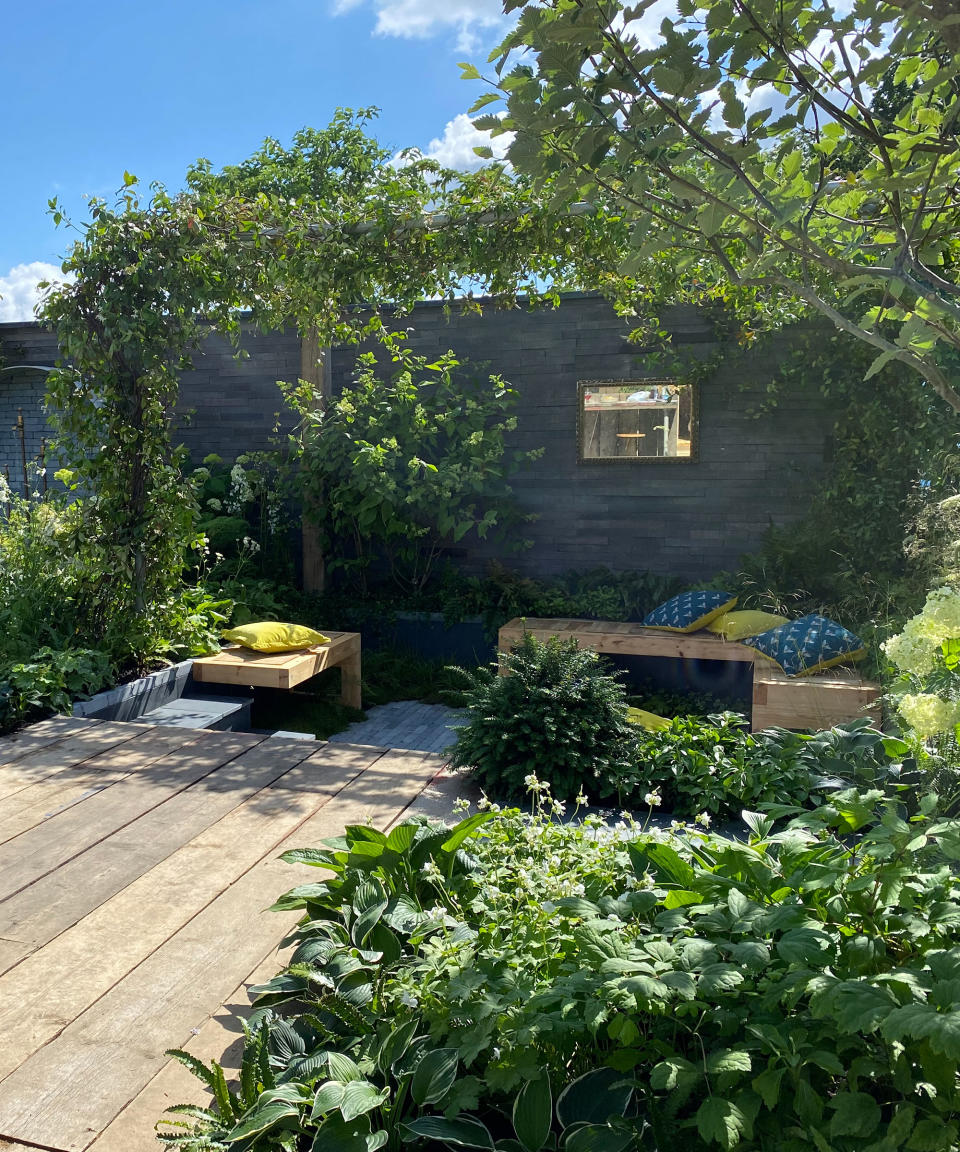
Keeping your pet pooch safe and secure is all important when they are outside, and your backyard walls and fences play an important role. Making sure that they are in good, solid condition without gaps and holes is obvious, but how many of us also consider the height and depth of our boundaries?
Some breeds of dog can easily jump over six-foot fences, while others can be hugely cunning using planters, storage boxes and raised garden beds as handy launch pads for their escape plans. Digging is another favorite pastime for many dogs and the lure of the outside world can be enough encouragement for them to tunnel under fences. Thwart their efforts by sinking the boundary a foot or two into the soil or paving up to the edge of the partition.
Of course, dog owners know their pets best, so common sense prevails when it comes to taking these precautions. Most pooches do like to see what is going on though, so if you are about thinking of building a fence or wall why not include a doggy porthole or window? Many composite fencing systems include decorative fretwork panels or even clear Perspex sections that can easily be incorporated into a run of solid fencing. Alternatively, if you are sticking to timber try sliding in a sturdy wood grill, trellis or even a clever Perspex viewing bubble, such as the BobbyPet dog fence window from Amazon, so your pet can get his nosey fix.
What is a good ground cover for a dog-friendly backyard?
Choosing durable and paw-friendly ground cover for your outside space can be tricky, especially if you need it to look good too, but there are a few options.
Bark chippings are great for doggy play areas away from the house. Good for digging in and burying their favorite toys in, they are soft and warm underfoot. Opt for cedar mulch if available as it has natural flea repelling qualities.
Rubber crumb is a great option for mature dogs, providing they don’t have a habit of chewing everything. Made from recycling old rubber tires it is environmentally friendly, free-draining and soft under-paw.
Pea gravel can be good for shady play areas too. It’s rounded shape is gentle underfoot and won’t get trapped in paws, plus it is easy and affordable to top up.
How do I build an outdoor dog area?
‘A little creativity goes a long way when creating a space for your furry friend. I like to activate unused or overlooked areas and give them a new purpose by converting them into pet spaces,’ says Karina Farah, designer at MC Design.
‘When designing an outdoor space for your pup always take into consideration temperature safety. There should be both exposed areas with sun and shaded areas to allow your pet to get out of the heat.
'When choosing turf, opt for ones that are engineered to withstand and disperse heat so that you don't risk it becoming too hot for your dog's paws. And install a spicket or water hose nearby to make clean up easy and water readily accessible.'
Creating a dog-friendly backyard doesn't have to be time consuming or expensive. Although there are some bigger improvements you can make, there are also plenty of budget backyard ideas that your pooch will love.
From creating shady spots where they can escape from the heat to dedicated areas where they can run around (and dig!) to their heart's content, making a few simple changes to the layout of your yard can keep everyone happy. And if you get it right, there's less chance of your prized flowers, lawn or crops in your veg patch getting trampled on by the paws of your furry friend.
